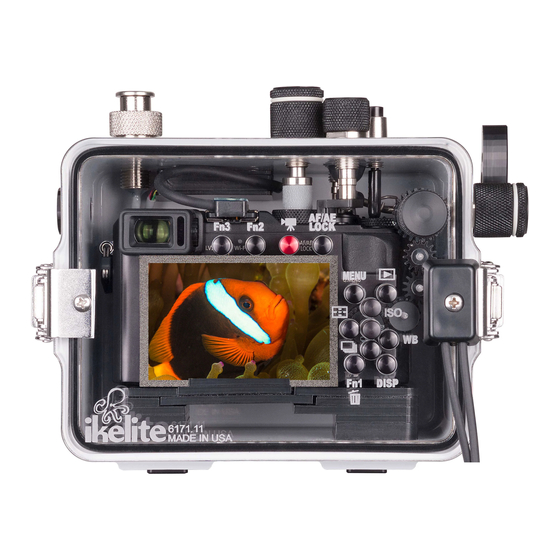Table of Contents
Advertisement
Quick Links
Download this manual
See also:
Manual
Advertisement
Table of Contents

Subscribe to Our Youtube Channel
Summary of Contents for Ikelite 6171.11
-
Page 1: Product Registration
Leica D-Lux (Typ 109) Product Number 6171.11 Product Registration Please register your product at ikelite.com within 15 days of purchase. Our product registration database is the best way for us to contact you in the event of a product update. -
Page 2: About This Product
About this Product Thank you for your purchase of Ikelite equipment. Please read this instruction manual completely before attempting to operate or dive with this product. Please visit ikelite.com to register your product to receive information on any updates, notices, or recalls pertaining to your equipment. -
Page 3: Important Notices
Do not remove the Accessory Port Plug unless you are » installing a compatible accessory. Your housing features one spare Accessory Port which may be used for attachment of factory optional or aftermarket housing accessories. The Accessory Port is 1/2-20 threaded. Visit ikelite.com for information on optional accessories. -
Page 4: Table Of Contents
Contents Product Registration About this Product Included in the Box Important Notices Accessory Port Getting to Know Your Housing Setting Up Your Camera Pre-Installation Checklist Setting Up Your Housing Opening the Housing Inserting the Camera Attaching the Hotshoe Closing the Housing Setting Up An External Strobe Strobe Compatibility Attaching a Sync Cord... -
Page 6: Getting To Know Your Housing
Getting to Know Your Housing Shutter speed Zoom Filter Bulkhead Shutter Lidsnap Lens Port Aperture Tray mounts... - Page 7 ON/OFF Rear * dial Accessory Exposure port compensation AE/FE LOCK MENU DISP Lid hook Lanyard O-ring Camera mount plate AE/FE LOCK Playback MENU White Balance MENU/SET DISP AF Mode Fn1/Delete Drive Mode...
-
Page 8: Setting Up Your Camera
Setting Up Your Camera Pre-Installation Checklist 1. Insert a fully charged camera battery. 2. Insert a properly formatted memory card. 3. In the REC menu, set Red-Eye Removal to OFF. 4. In the C menu, set Shutter AF to ON. 5. -
Page 9: Inserting The Camera
2. Lid snaps are designed to provide enough force to compress the o-ring for a proper seal. Keep firm pressure against the lid snap while lifting it away. Lid Snap Lock 3. Repeat with remaining lid snaps. 4. Remove the housing back. Inserting the Camera 1. - Page 10 4. Line up the mounting screw with the camera’s tripod socket. Use a flat head screwdriver to tighten the mounting plate to the camera. Camera tripod socket Mounting screw 1/4-20 tripod mount FRONT 5. Pull out on the housing’s ON/OFF, Shutter Speed, and Exposure Compensation knobs to move them out of the way.
-
Page 11: Attaching The Hotshoe
Attaching the Hotshoe 1. Make sure the contacts are clean. 2. Slide the hotshoe onto the camera with the “Front” arrow pointing towards the front of the camera. 3. Push the hotshoe forward until it is unable to go any farther. The hotshoe must be pushed all of the way forward to make proper contact with the camera and provide TTL operation. -
Page 12: Setting Up An External Strobe
All Ikelite DS strobes are capable of providing TTL operation with this system except: •... -
Page 13: Taking Your Housing In The Water
5. Attach the other end(s) of the sync cord to the bulkhead(s) on your strobe(s). 6. If using an Ikelite strobe, set the strobe to TTL. If using a non-Ikelite strobe, set the strobe to manual flash and select a manual power setting. -
Page 14: Entering The Water
3. Make sure that the camera can take and record a photo. 4. Check battery life and open storage space on your memory card. 5. Check your external flash, if using. 6. Submerge the housing in a fresh water tank dedicated to underwater photography equipment. -
Page 15: Maintenance
Maintenance Post-Dive 1. Rinse the housing in fresh water. Rotate the housing’s controls and press each button while submerged in fresh water to flush out any salt or debris to ensure smooth operation on future dives. 2. NEVER leave your housing in the fresh water rinse tank. Collisions with other peoples’... -
Page 16: Troubleshooting
8. Like regulators and other pressure-sensitive equipment, we recommend careful care and cleaning along with annual replacement of the factory seals. Troubleshooting Water enters the housing • Re-clean and re-install the main o-ring. • Take the housing underwater without a camera installed to ensure that the leaking has been corrected. - Page 17 Buttons are stuck • Soak the housing in lukewarm fresh water. Depress each button several times while the housing is submerged. • Apply lubricant to the button. Press the button several times to distribute the lubricant. • Check each housing control while underwater to ensure that they are disengaged.
-
Page 18: Service And Repairs
Service and Repairs Ikelite is most interested in performing any service to ensure that all products perform as intended. Evidence of purchase date must be provided to obtain warranty service. No prior authorization is required. You may return directly to us or through your dealer. Please include a brief description of the problem, any relevant email correspondence, and/or description of the service request. -
Page 19: Contact Us
If you have any questions about your product or need advice on getting the images you want, please get in touch with us and we’ll do everything we can to help you capture your unique perspective. Ikelite Underwater Systems 50 W 33rd St Indianapolis, IN 46208 USA (317) 923-4523 ikelite@ikelite.com...












Need help?
Do you have a question about the 6171.11 and is the answer not in the manual?
Questions and answers